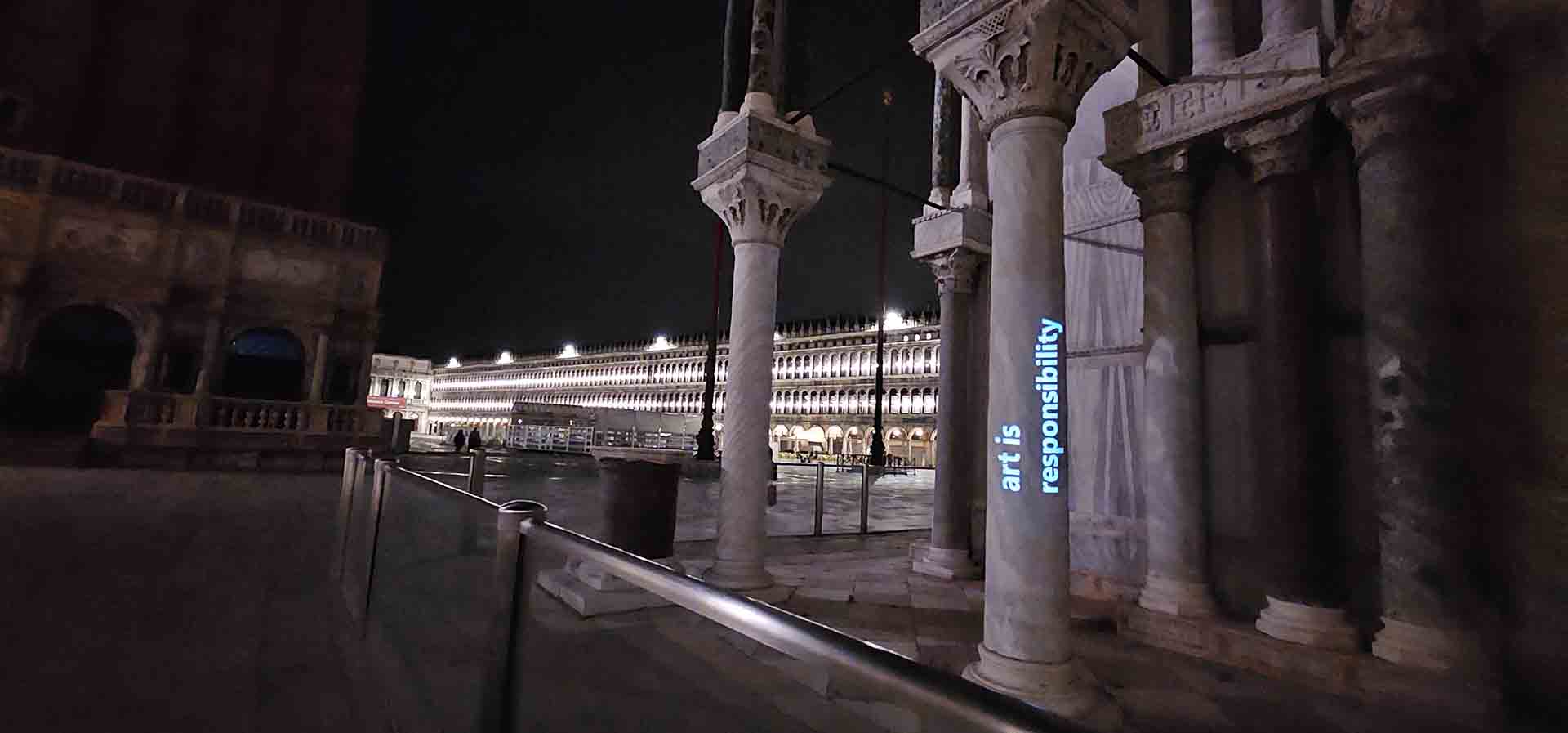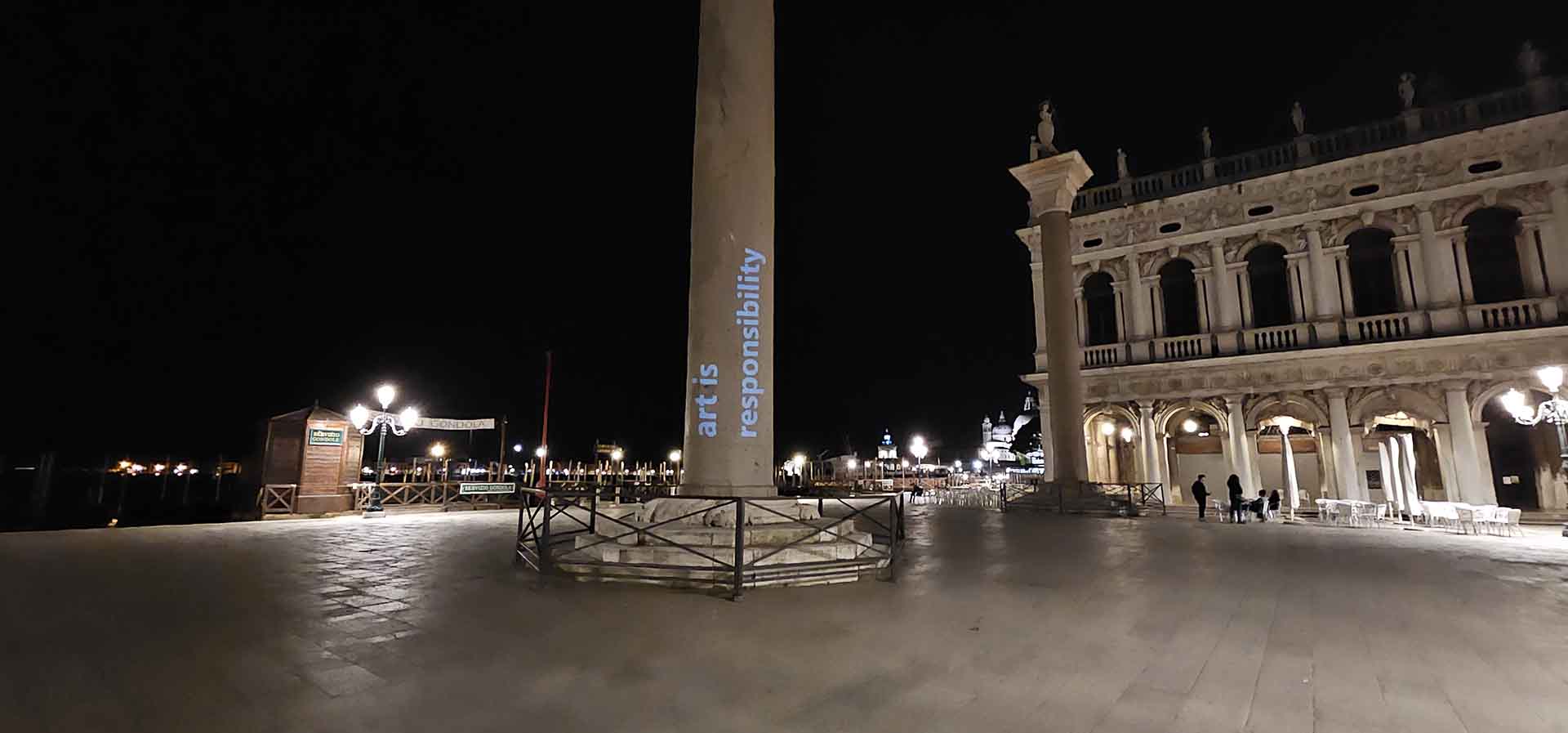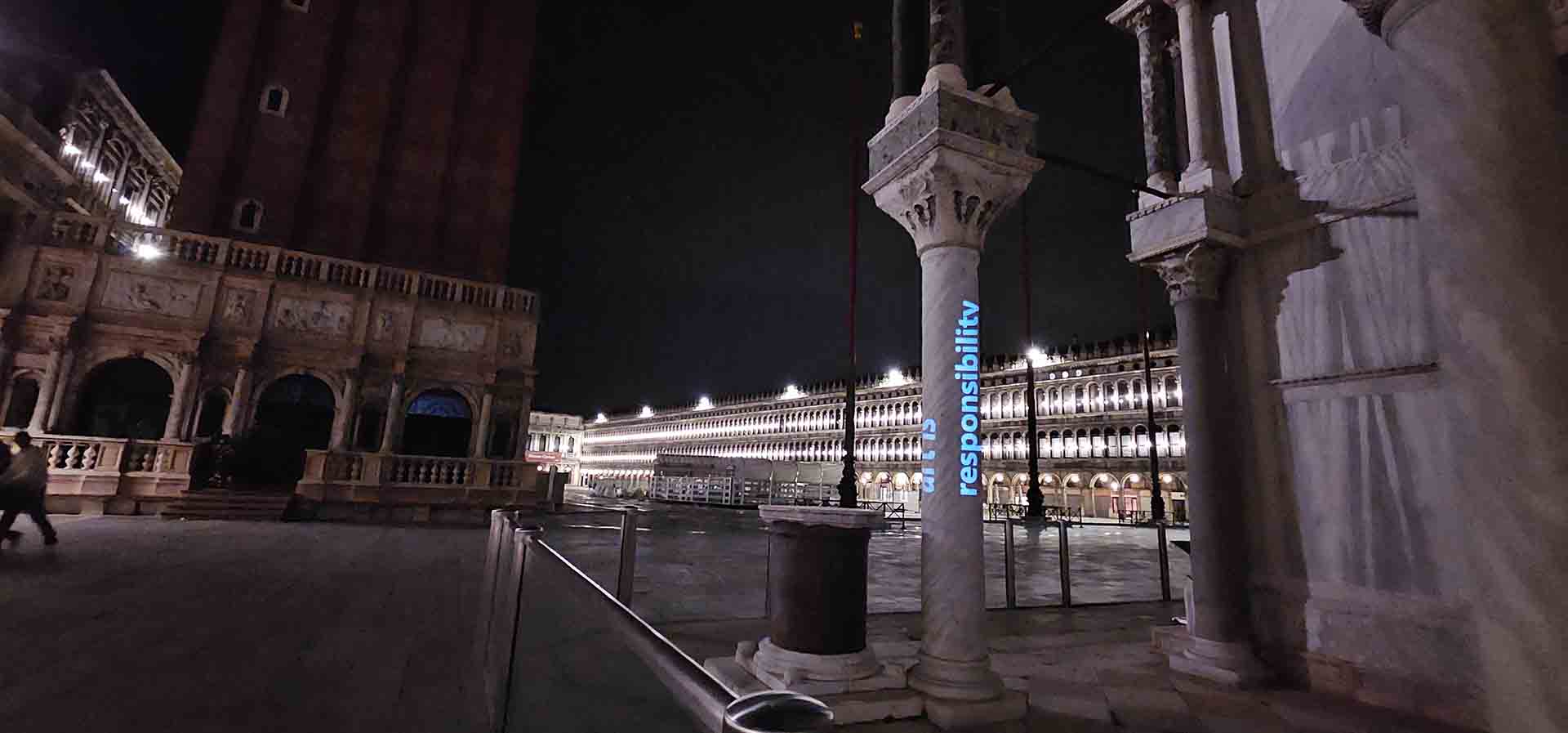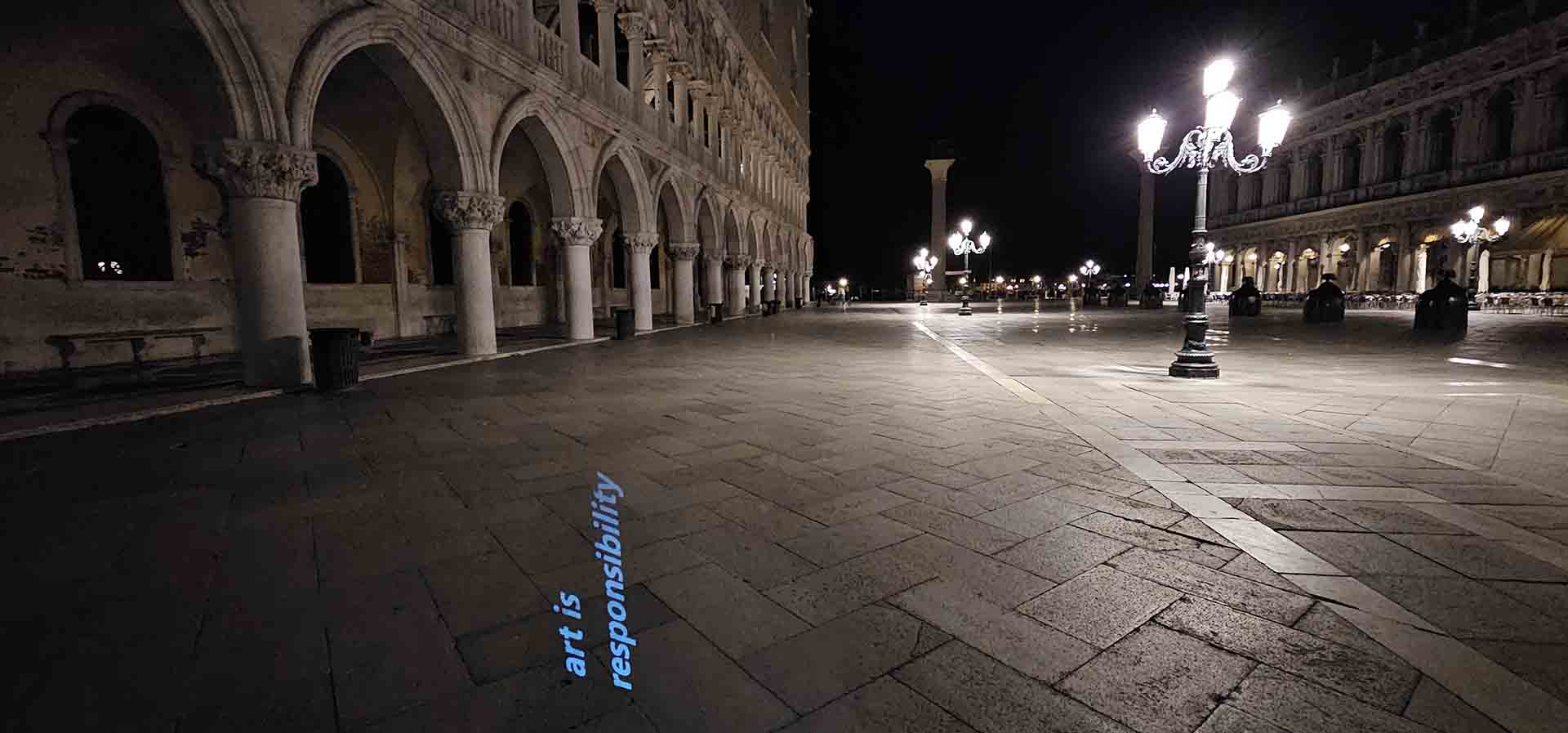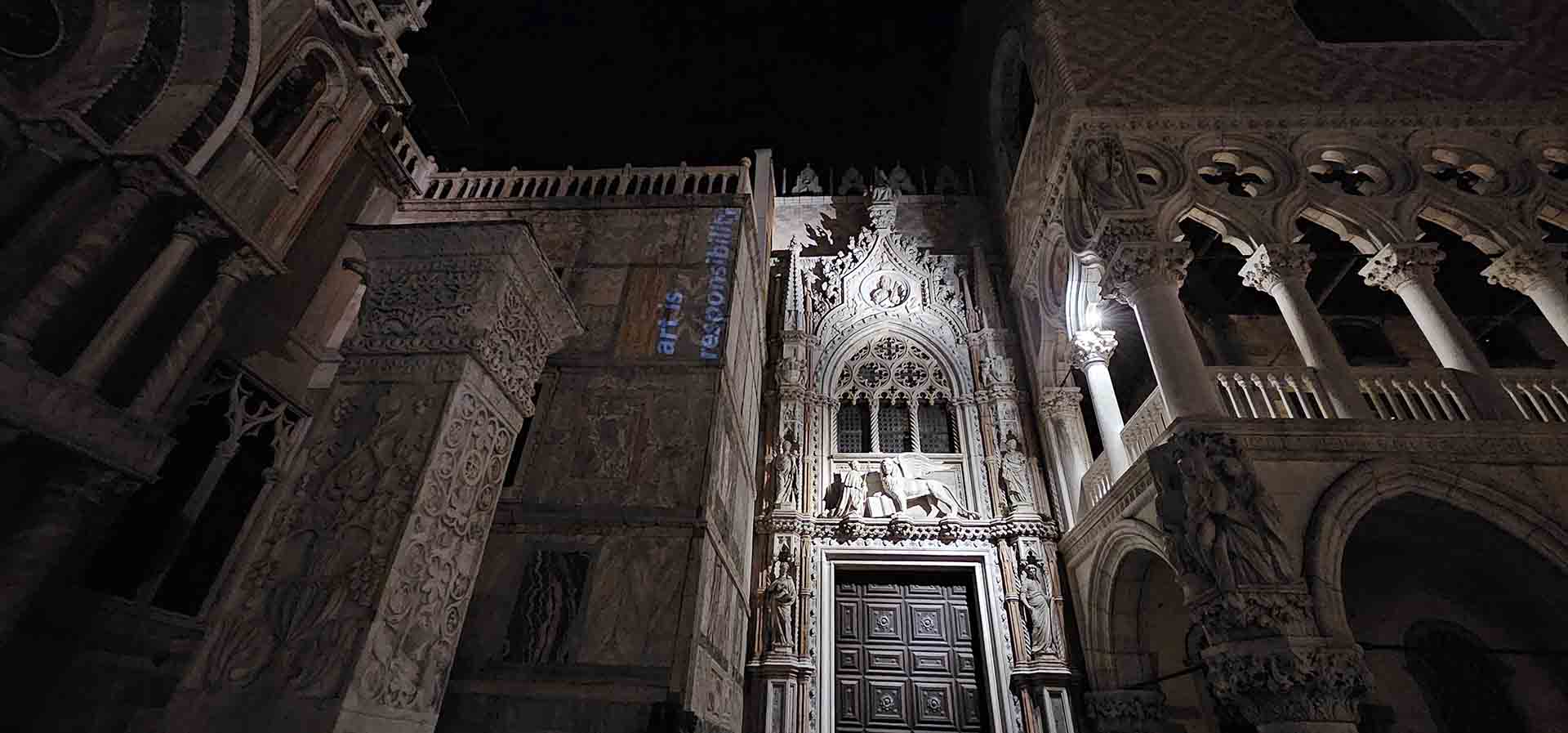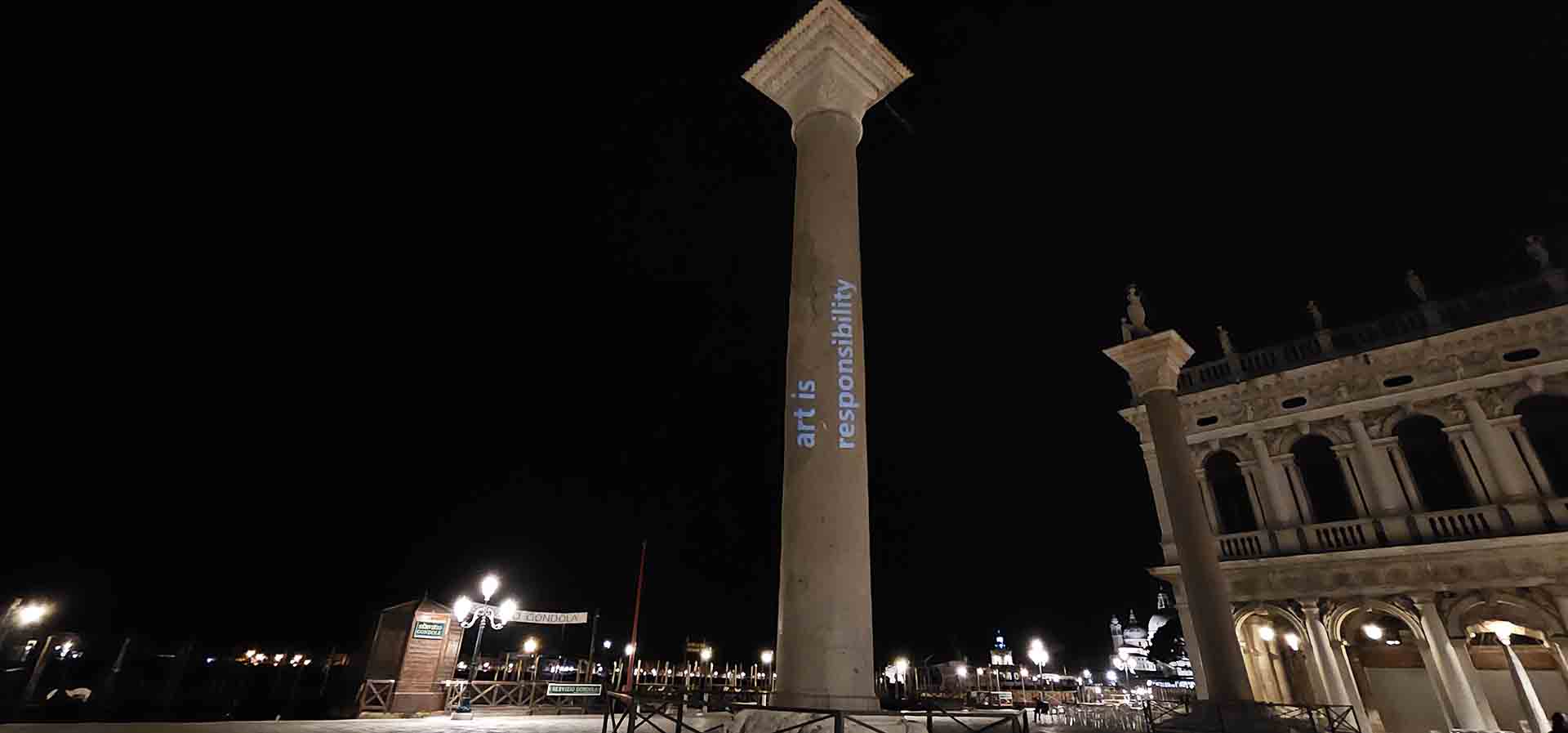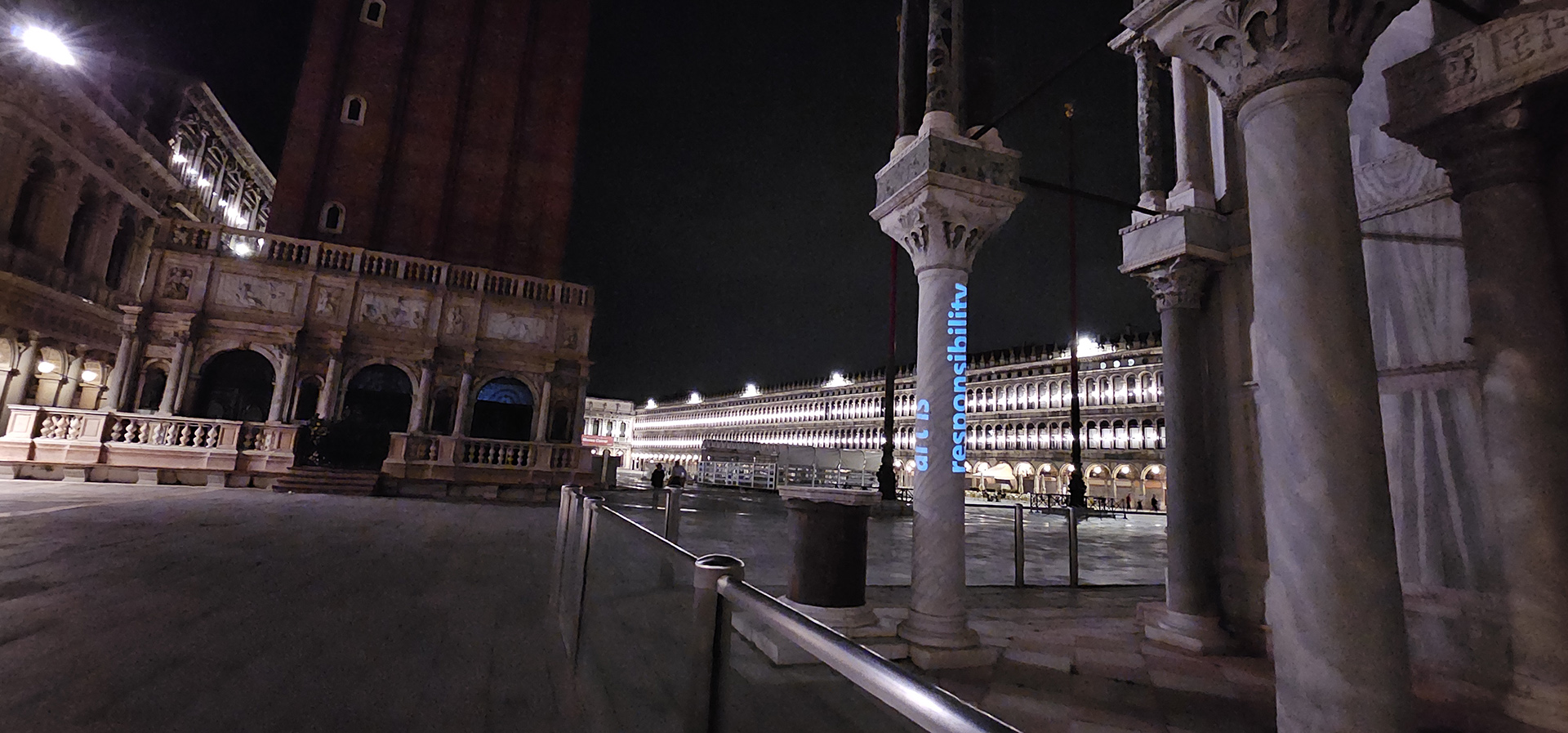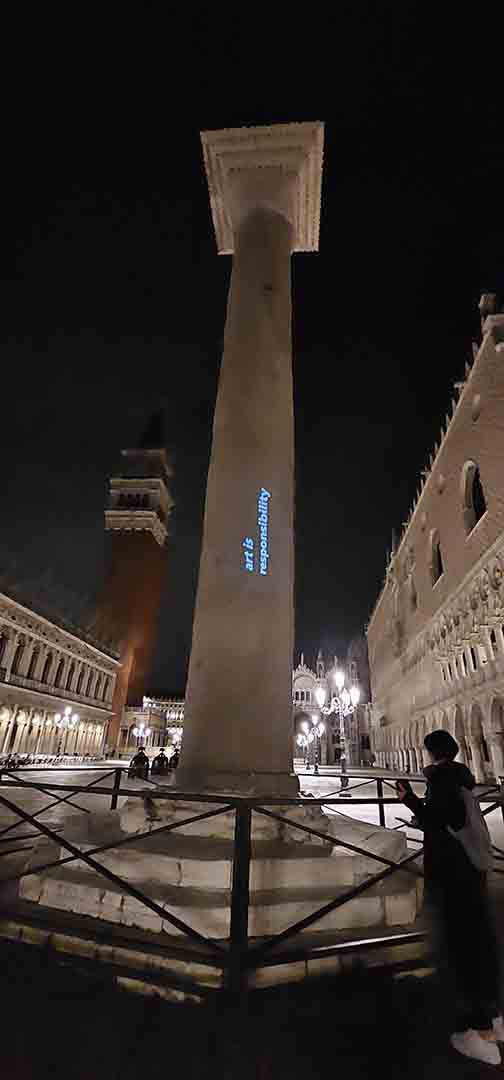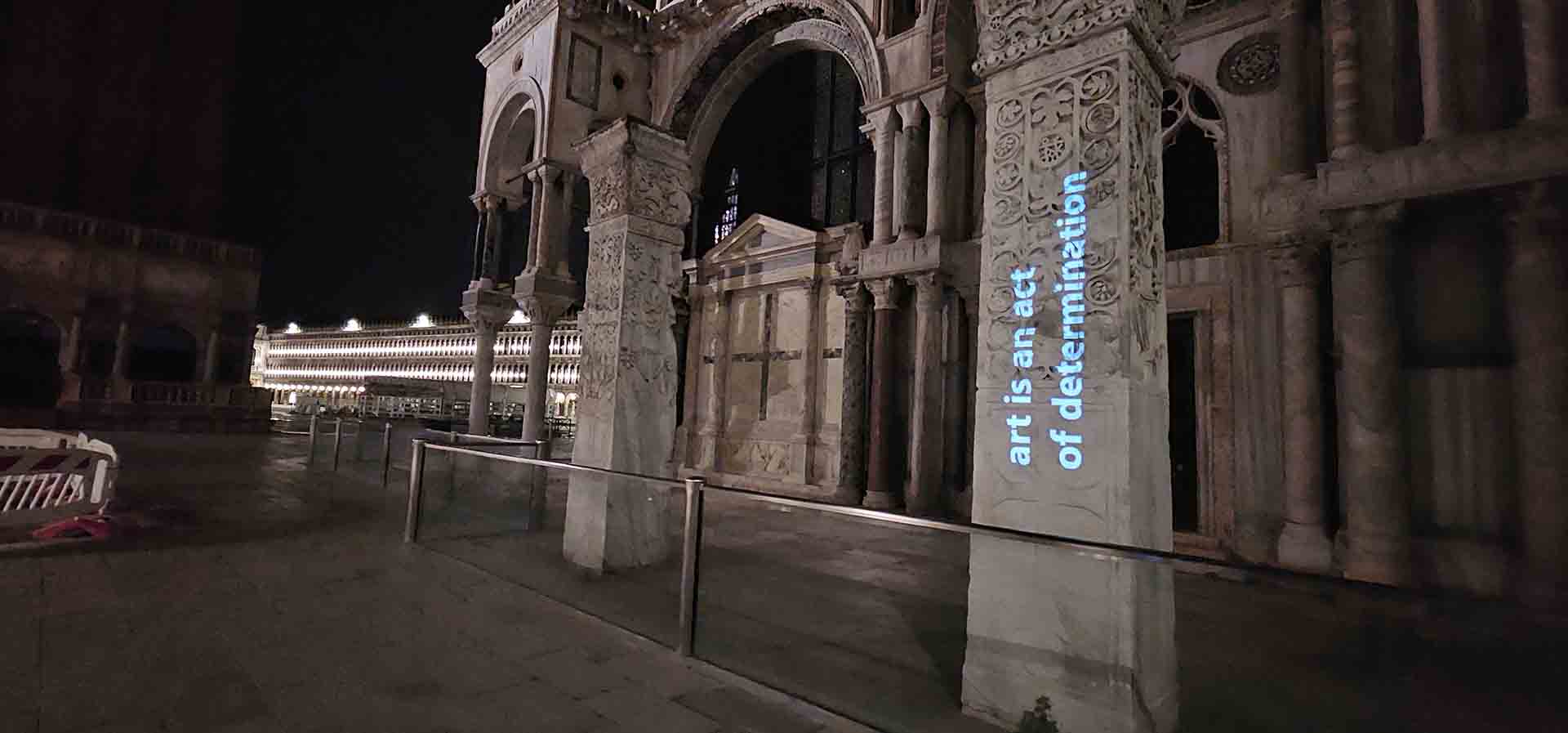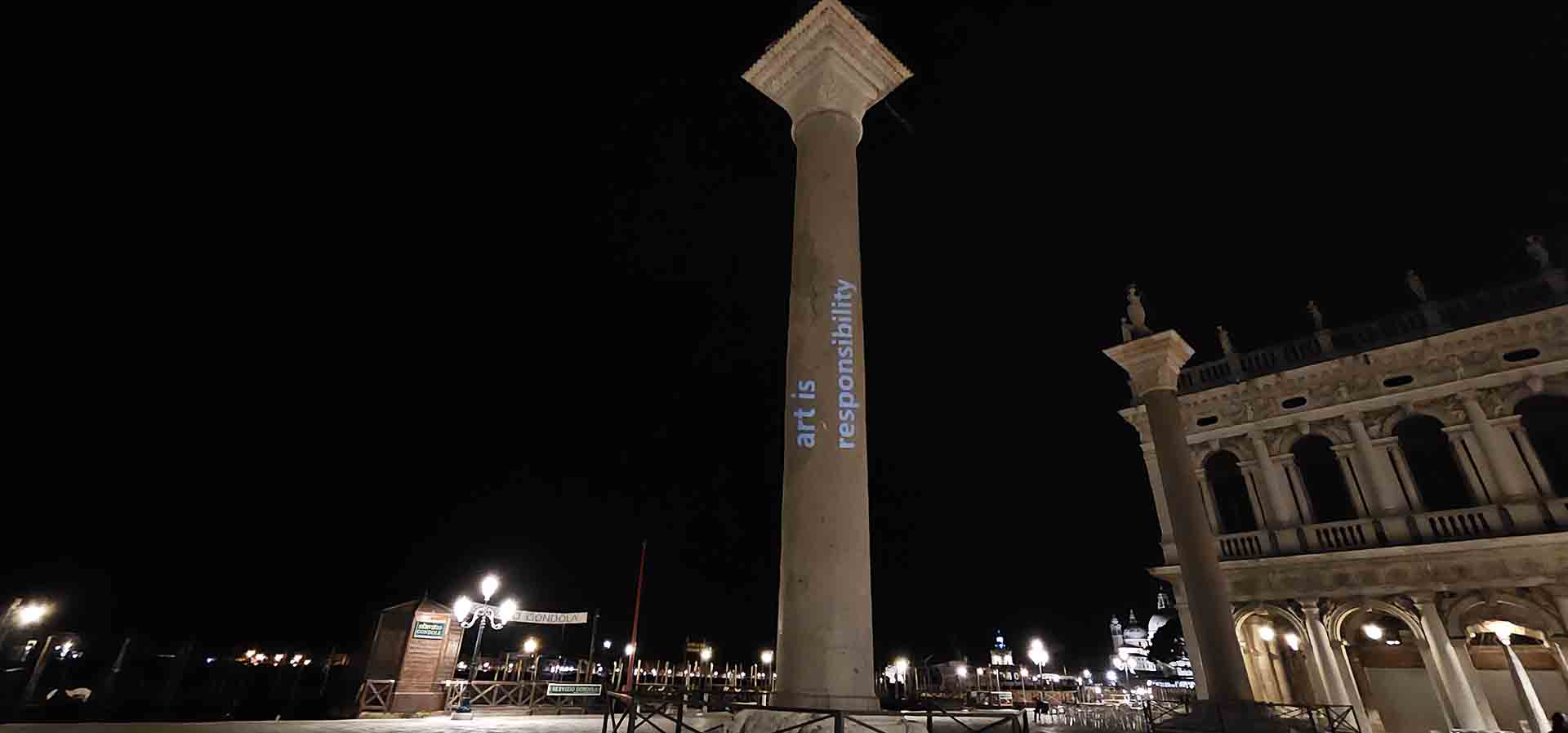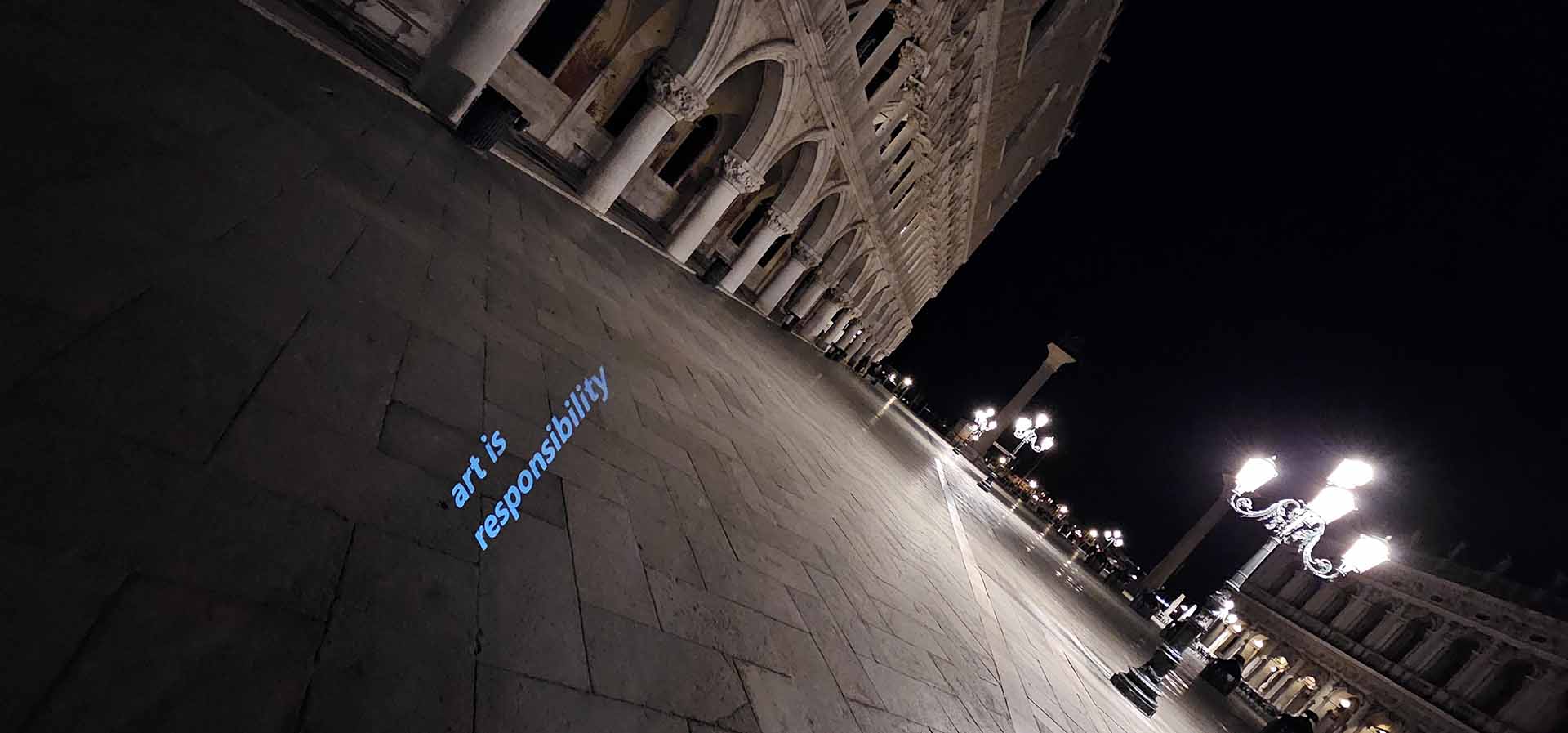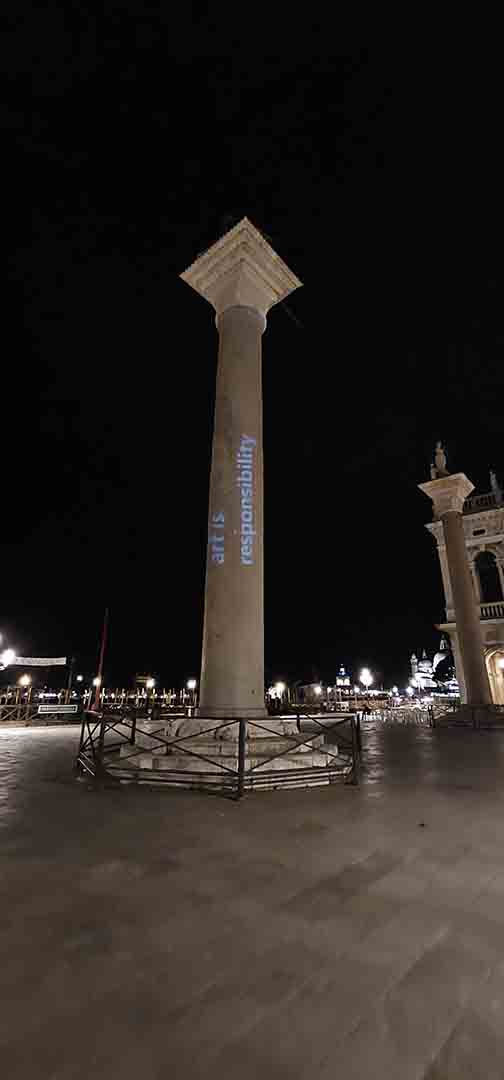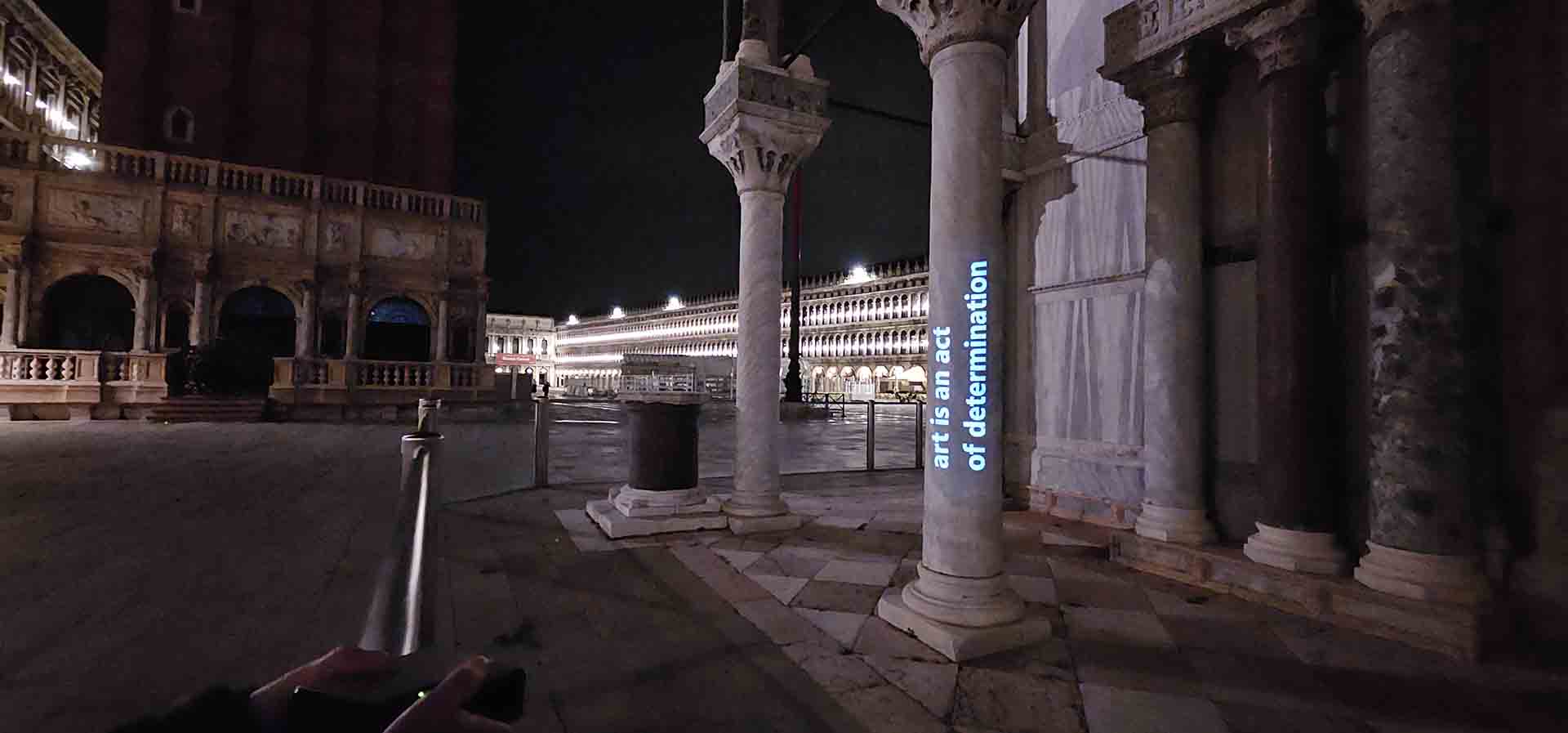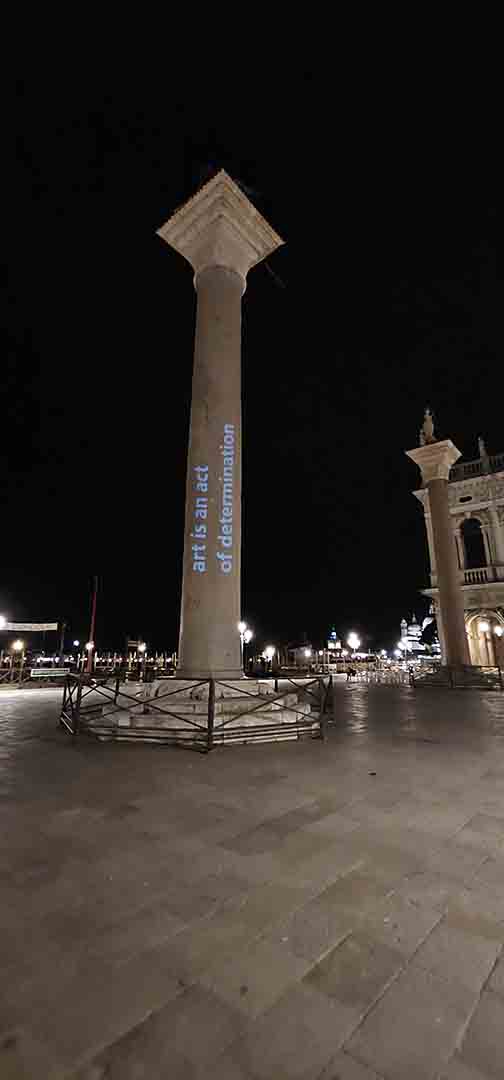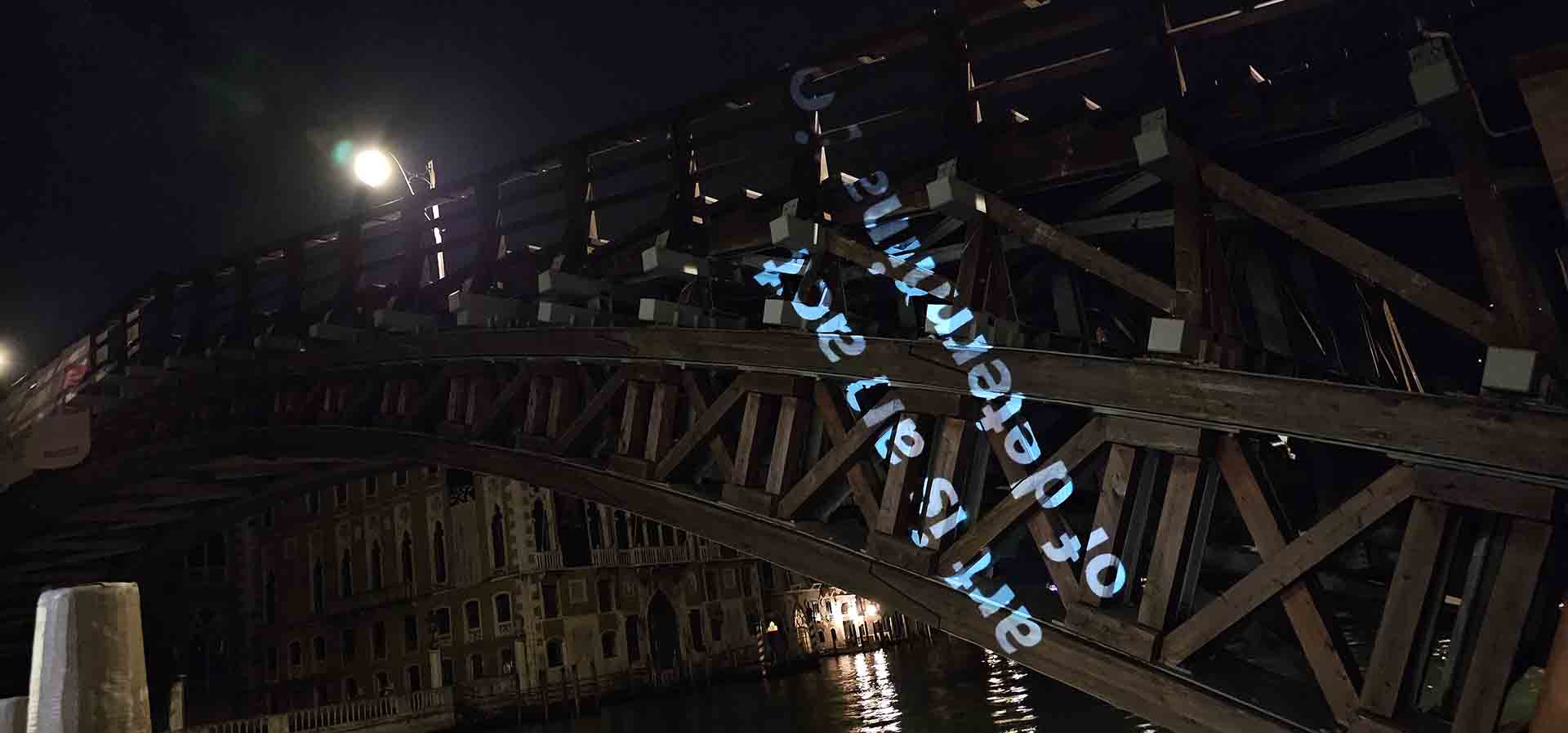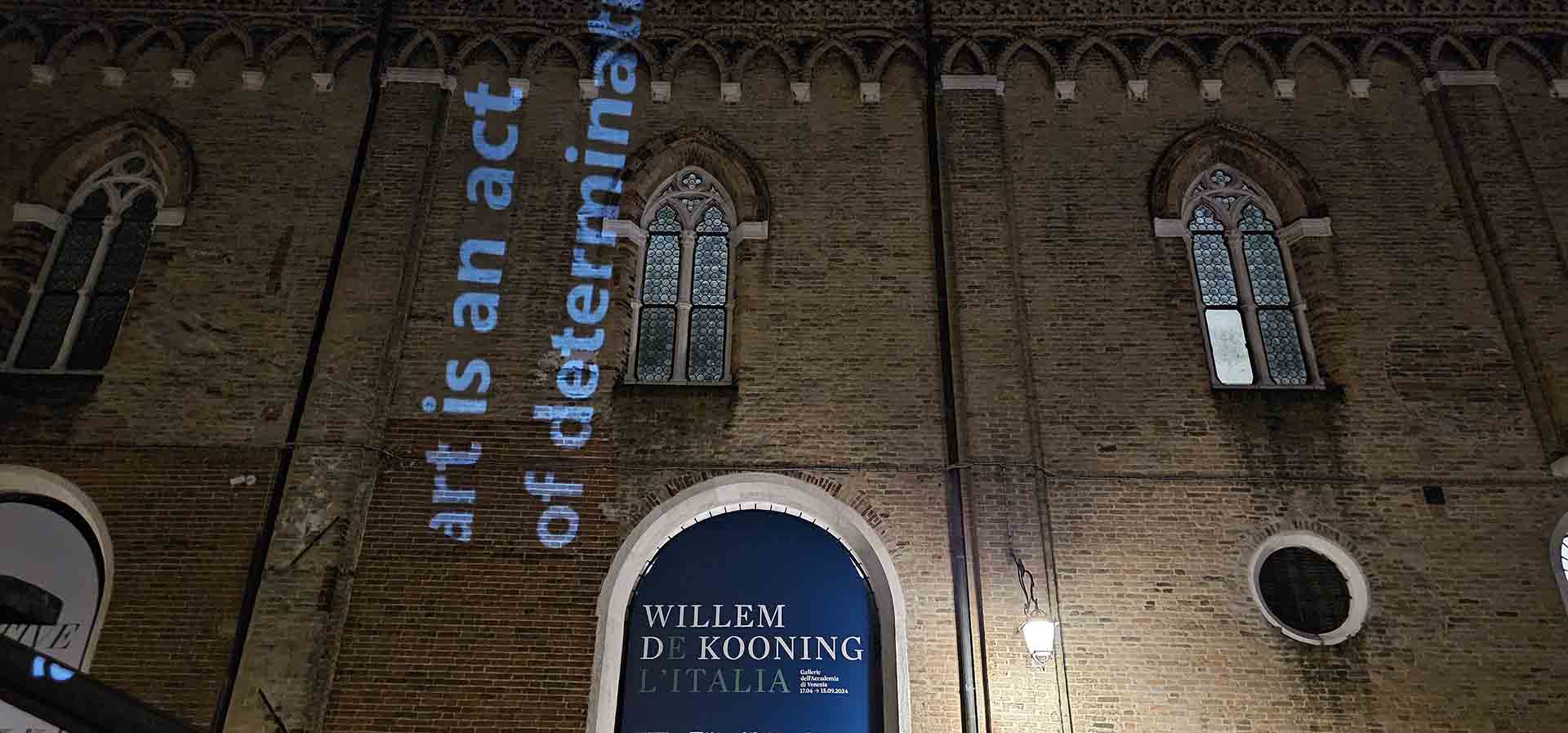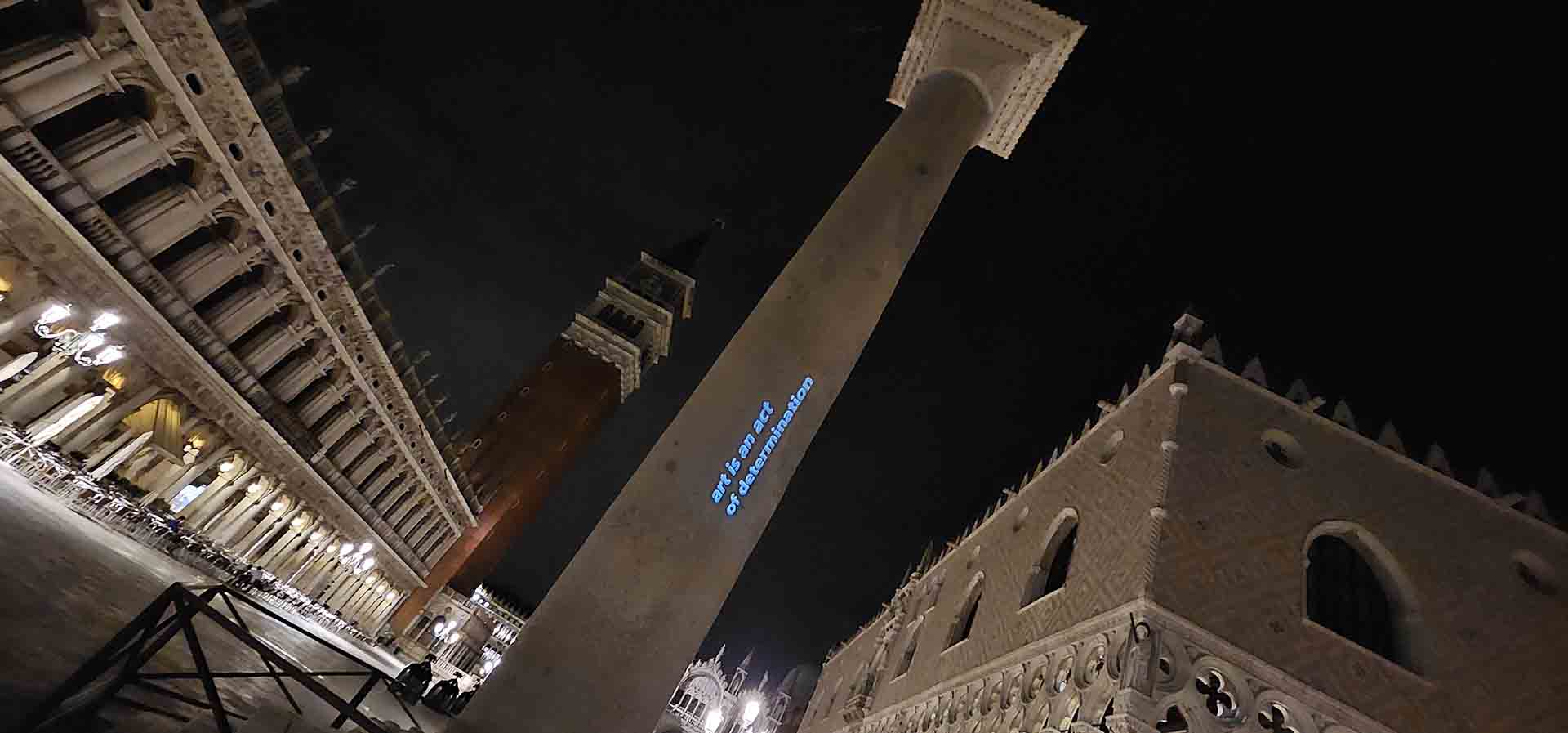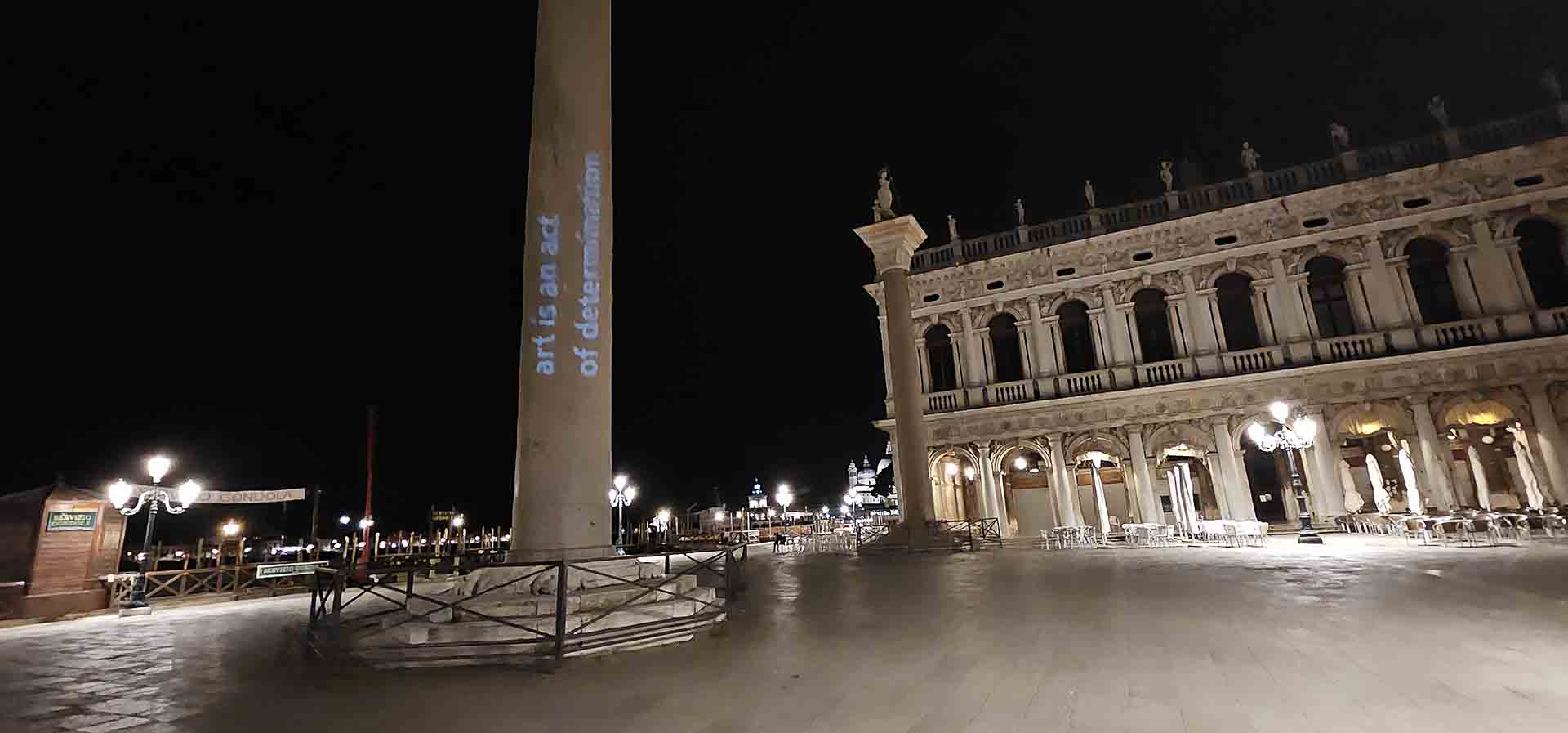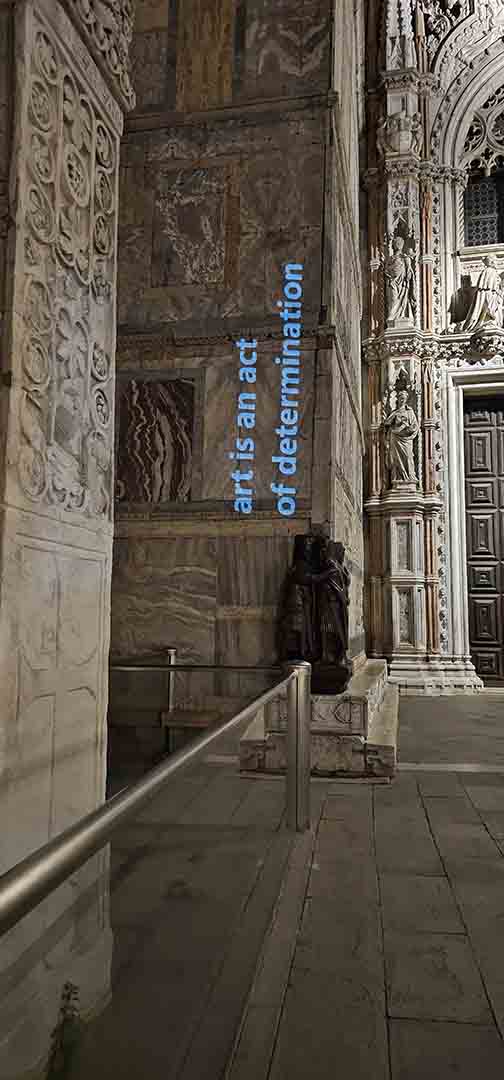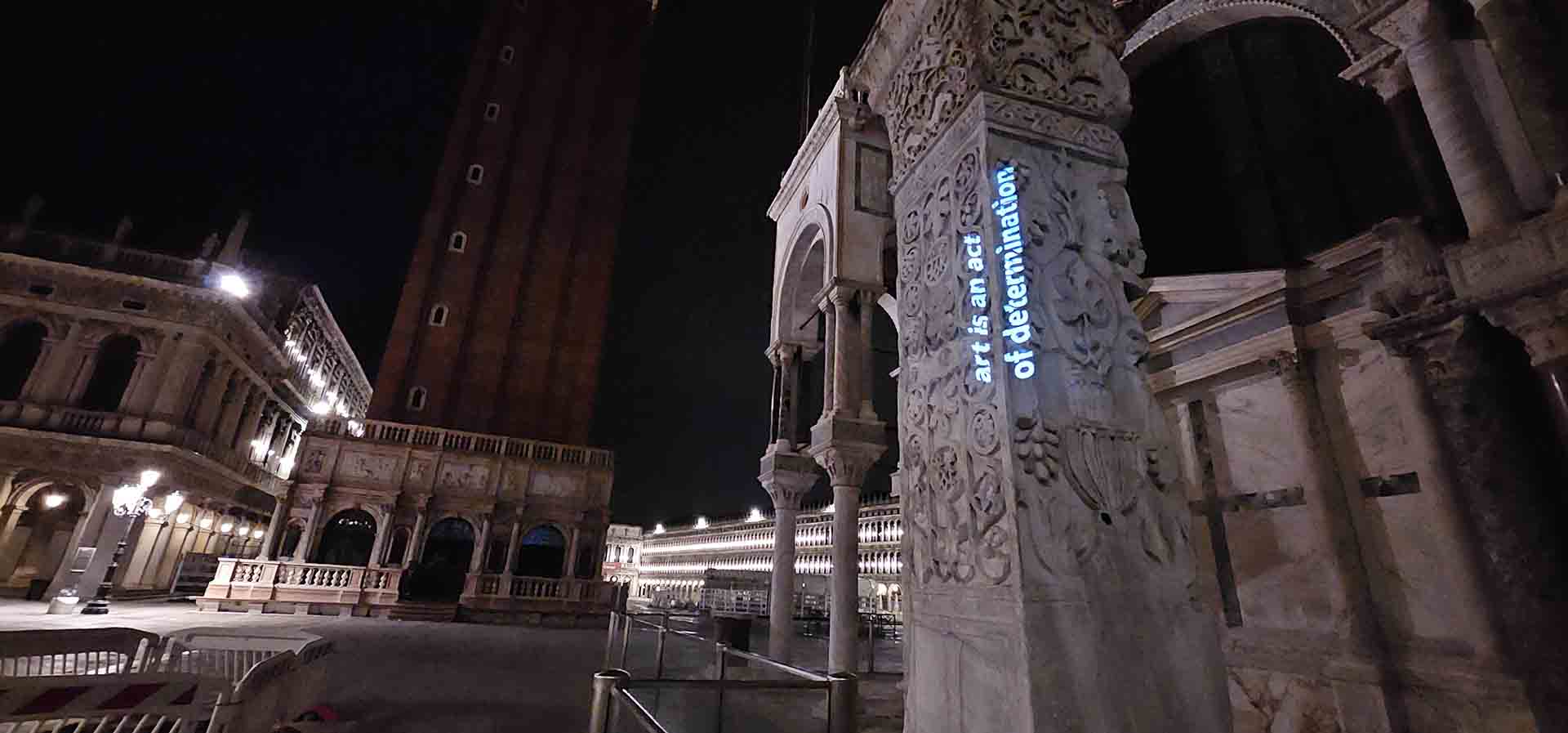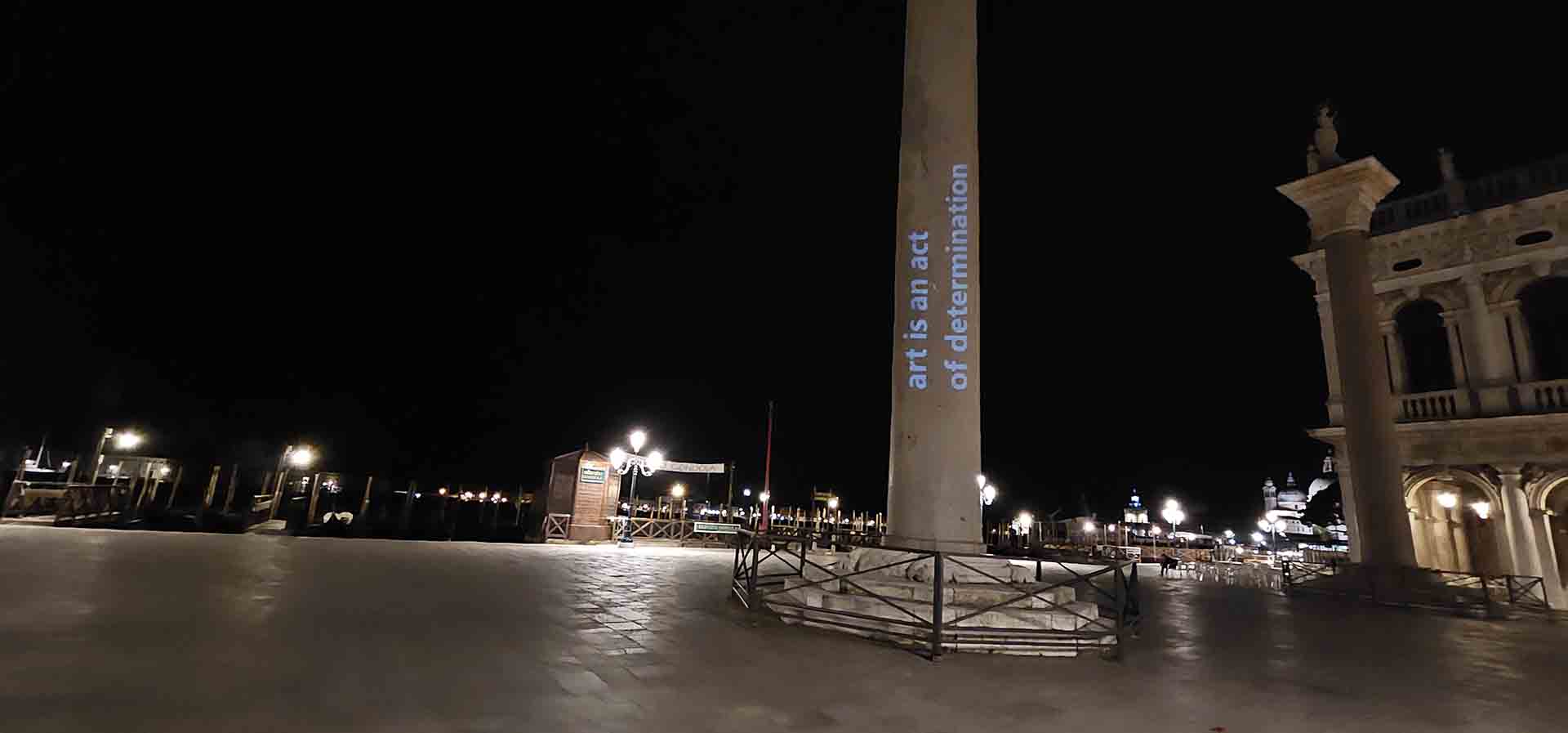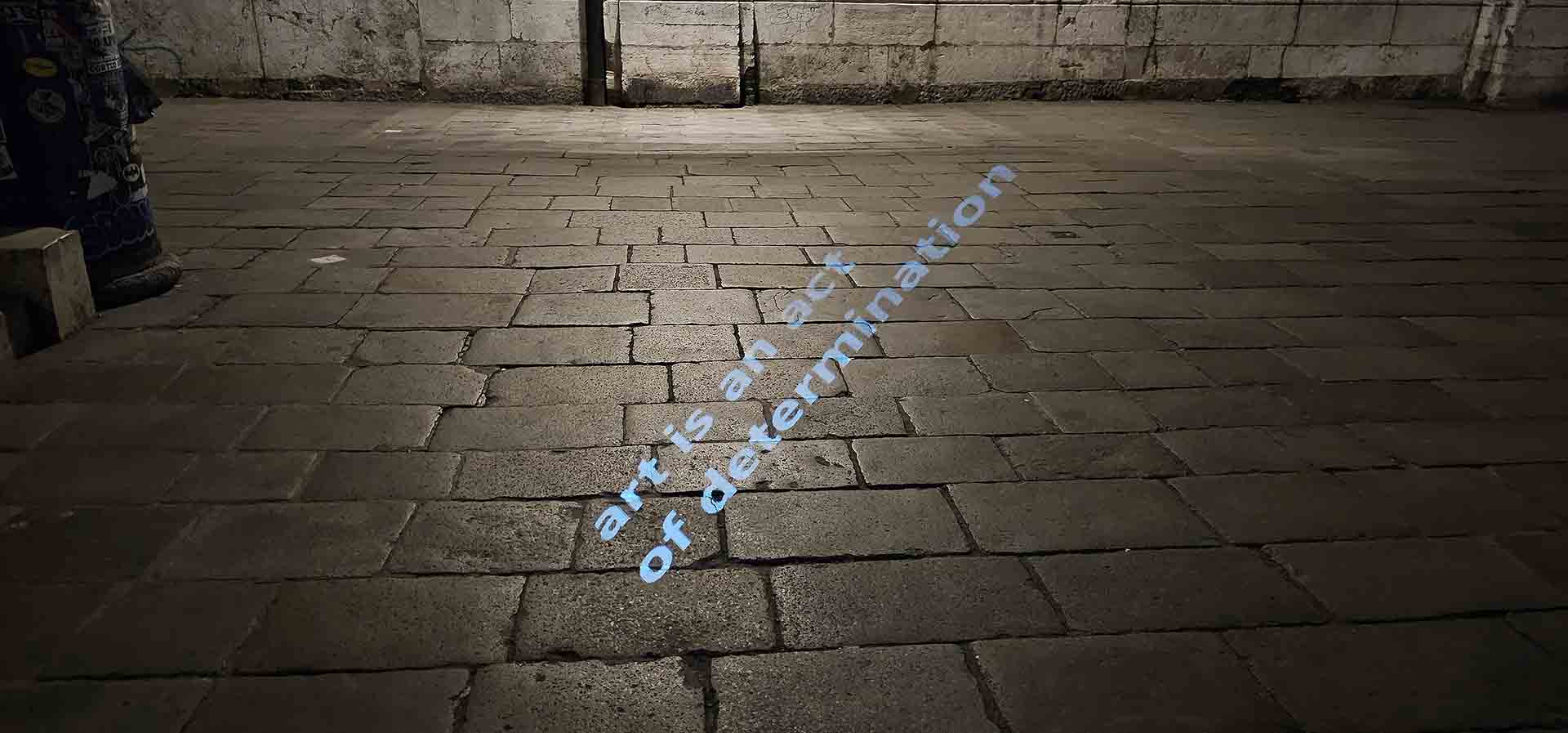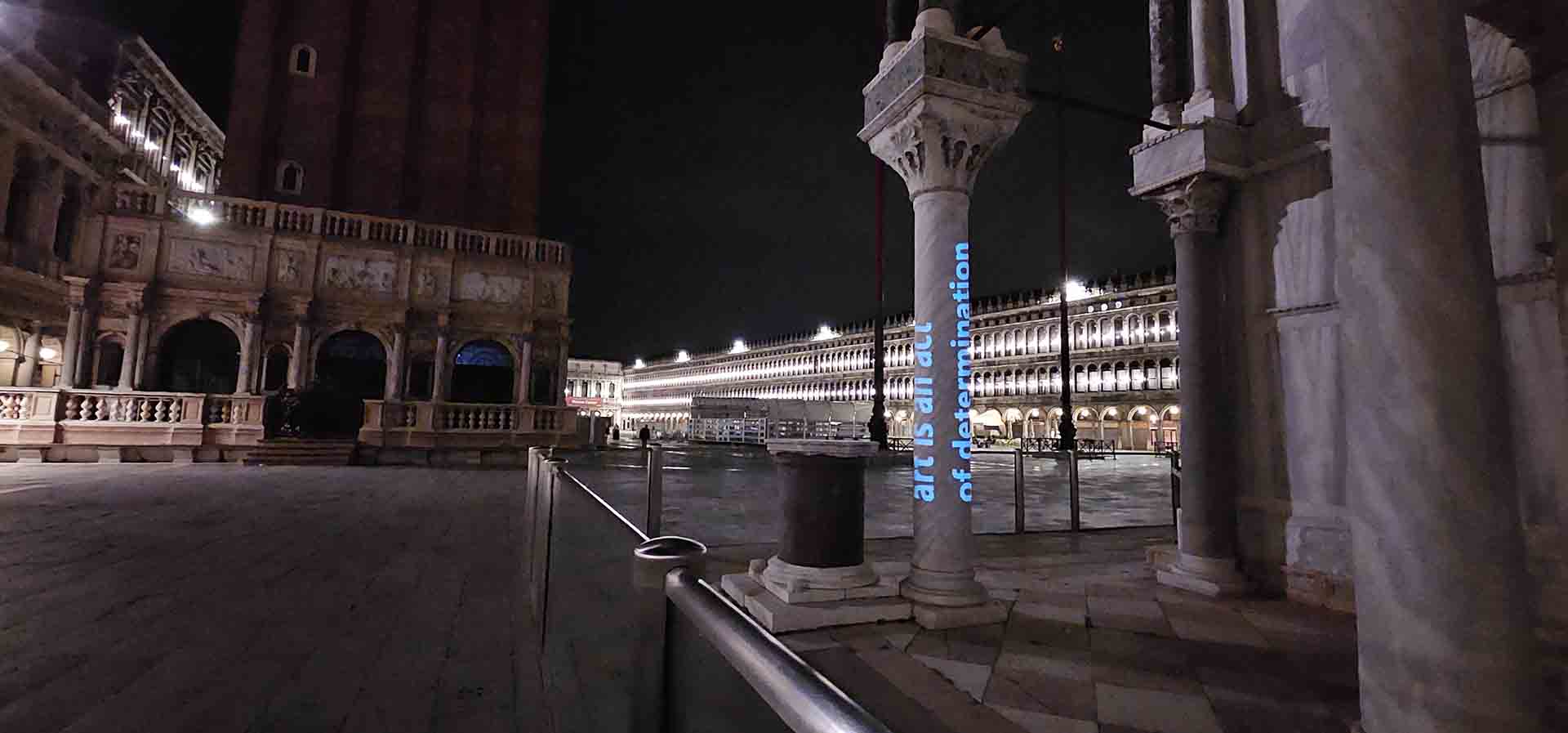TEXT AS A VISUAL FORM
ART IS RESPONSIBILITY, 2024
Light Intervention, Venice, 2024 | Interwencja świetlna, Wenecja, 2024
ART IS AN ACT OF DETERMINATION, 2024
Light Intervention, Venice, 2024 | Interwencja świetlna, Wenecja, 2024
[ENG]
Light as Text: A Venice Intervention (May 2024)
This text is a reflection on an artistic activity carried out in the public space of Venice in May 2024. The project consisted of a light intervention, consisting of the projection of the texts „art is an act of determination” and „art is responsibility” onto the architecture of the city – columns, facades, square slabs. The work fits into the trend of conceptual and intervention art, examining the limits of visibility, meaning and the impact of light as a carrier of ideas in the context of the unique urban fabric of the city. The activity took place in parallel with the 2024 Art Biennale, which gives it an additional dimension of dialogue with the global art world.
Venice, a city with a unique topography and photosensitive architecture, is an extremely intense field for reflection on the relationship between art and space. As a place highly saturated with cultural, historical and artistic symbols, Venice becomes not only a stage, but also a living participant in the artistic activity. In this context, the light project carried out in 2024 aimed to create a temporary intervention that uses light as a medium of communication and architecture as a semantic screen.
Context of the Biennale
The action took place during the Venice Biennale – an event that has shaped global artistic discourse since 1895. The Biennale, although monumental and institutional in itself, often inspires actions of a peripheral, interventionist, critical nature. This text projection was precisely such a form: intimate but visible; ephemeral but striking in its meaning.
Light as intervention
The texts “art is an act of determination” and “art is responsibility” were projected in various locations in Venice: on the columns of the Doge’s Palace, on the marble slabs of St. Mark’s Square, on the façade of the Gothic gallery hosting Willem de Kooning’s exhibition. Their locations were not accidental – they concerned symbolic nodal points of the city, where architecture is a carrier of history and power. In this approach, light became both a commentary and a question about the creator’s responsibility and determination as an act of aesthetic and ethical will.
Text as a visual form
Inspired by the concepts of asemic writing and typographic minimalism, the form of the text was designed in a clear and rhythmic way. The use of a vertical arrangement of words (on columns) or horizontal (on the square) emphasized the relationship of form to surface. In this sense, the work fits into strategies known from actions such as the realizations of Jenny Holzer or Lawrence Weiner – where language functions as a material, but also as an artistic gesture1.
Architecture as a screen of meanings
The project was not about „illuminating” architecture, but about its transfiguration through meaning. The wall of a Gothic church, a Renaissance arcade, a stone floor – all these elements carried their own history, which was temporarily rewritten by text. Light made them active carriers of a contemporary message. This action, although impermanent, generated a strong tension between the past and the present, memory and the current.
Reception and intention
The choice of English language was aimed at the universality of the message. The project was not participatory in the traditional sense – it did not require interaction – but assumed the active presence of the recipient: a passer-by, a tourist, a resident. The slogans, through their brevity and seriousness, acted like modern mantras. They did not offer simple answers – but created space for reflection on the place of art in social life.
The light intervention in Venice was not only an artistic gesture, but also an examination of urban perception, a test of the visibility of meaning and an experiment with textual form in space. It was an attempt to clash the transience of light with the durability of architecture, as well as a record of the spiritual and intellectual presence of art in times of visual and semantic overload.
________________________________________
Bibliography
1. Barthes, R. (1977). Image–Music–Text. Fontana Press.
2. Holzer, J. (1990). Protect Protect. Hatje Cantz.
3. Weiner, L. (2007). Statements. Primary Information.
4. Kristeva, J. (1984). Revolution in Poetic Language. Columbia University Press.
5. Eco, U. (1979). A Theory of Semiotics. Indiana University Press.
6. Agamben, G. (1999). The Man Without Content. Stanford University Press.
[PL]
Światło jako tekst: interwencja w Wenecji (maj 2024)
Niniejszy tekst stanowi refleksję nad artystycznym działaniem zrealizowanym w przestrzeni publicznej Wenecji w maju 2024 roku. Projekt polegał na interwencji świetlnej, polegającej na projekcji tekstów „art is an act of determination” oraz „art is responsibility” na architekturę miasta – kolumny, fasady, płyty placów. Praca wpisuje się w nurt sztuki konceptualnej i interwencyjnej, badając granice widzialności, znaczenia oraz wpływu światła jako nośnika idei w kontekście wyjątkowej tkanki urbanistycznej miasta. Działanie odbyło się równolegle z Biennale Sztuki 2024, co nadaje mu dodatkowy wymiar dialogu z globalnym światem sztuki.
Wenecja, miasto o niepowtarzalnej topografii i światłoczułej architekturze, stanowi niezwykle intensywne pole do refleksji nad relacją pomiędzy sztuką a przestrzenią. Jako miejsce o wysokim nasyceniu symbolami kulturowymi, historycznymi i artystycznymi, Wenecja staje się nie tylko sceną, ale i żywym uczestnikiem artystycznego działania. W tym kontekście projekt świetlny zrealizowany w 2024 roku miał na celu stworzenie tymczasowej interwencji, która wykorzystuje światło jako medium komunikatu oraz architekturę jako ekran semantyczny.
Kontekst Biennale
Działanie odbywało się w okresie trwania Biennale Sztuki w Wenecji – wydarzenia, które od 1895 roku kształtuje globalny dyskurs artystyczny. Biennale, choć samo w sobie monumentalne i instytucjonalne, często inspiruje działania o charakterze peryferyjnym, interwencyjnym, krytycznym. Niniejsza projekcja tekstowa stanowiła właśnie taką formę: intymną, ale widoczną; efemeryczną, ale uderzającą w swym znaczeniu.
Światło jako interwencja
Teksty „art is an act of determination” i „art is responsibility” zostały rzutowane w różnych lokalizacjach Wenecji: na kolumnach Pałacu Dożów, na marmurowych płytach Placu Świętego Marka, na fasadzie gotyckiej galerii w której prezentowano wystawę Willema de Kooninga. Ich lokalizacje nie były przypadkowe – dotyczyły symbolicznych punktów węzłowych miasta, w których architektura stanowi nośnik historii i władzy. Światło w tym ujęciu stało się zarówno komentarzem, jak i pytaniem o odpowiedzialność twórcy i o determinację jako akt woli estetycznej i etycznej.
Tekst jako forma wizualna
Zainspirowana koncepcjami asemic writing i minimalizmu typograficznego, forma tekstu została zaprojektowana w sposób klarowny i rytmiczny. Użycie pionowego układu słów (na kolumnach) czy horyzontalnego (na placu) podkreślało relację formy do powierzchni. W tym sensie praca wpisuje się w strategie znane z działań takich jak realizacje Jenny Holzer czy Lawrence’a Weinera – gdzie język funkcjonuje jako materiał, ale też jako gest artystyczny1.
Architektura jako ekran znaczeń
W projekcie nie chodziło o „iluminację” architektury, lecz o jej transfigurację poprzez sens. Ściana kościoła gotyckiego, arkada renesansowa, kamienna posadzka – wszystkie te elementy niosły własną historię, która została chwilowo przepisana tekstem. Światło uczyniło je aktywnymi nośnikami współczesnego przesłania. To działanie, choć nietrwałe, generowało silne napięcie pomiędzy przeszłością a teraźniejszością, pamięcią a aktualnością.
Recepcja i intencja
Wybór języka angielskiego miał na celu uniwersalność komunikatu. Projekt nie miał charakteru partycypacyjnego w tradycyjnym sensie – nie wymagał interakcji – ale zakładał aktywną obecność odbiorcy: przechodnia, turysty, mieszkańca. Hasła, poprzez swoją lakoniczność i powagę, działały jak współczesne mantry. Nie oferowały prostych odpowiedzi – lecz stwarzały przestrzeń dla refleksji o miejscu sztuki w życiu społecznym.
Świetlna interwencja w Wenecji była nie tylko artystycznym gestem, ale też badaniem miejskiej percepcji, testem widzialności znaczenia i eksperymentem z formą tekstową w przestrzeni. Była próbą zderzenia ulotności światła z trwałością architektury, a także zapisem duchowej i intelektualnej obecności sztuki w czasach przeciążenia wizualnego i semantycznego.
________________________________________
Bibliografia
- Barthes, R. (1977). Image–Music–Text. Fontana Press.
- Holzer, J. (1990). Protect Protect. Hatje Cantz.
- Weiner, L. (2007). Statements. Primary Information.
- Kristeva, J. (1984). Revolution in Poetic Language. Columbia University Press.
- Eco, U. (1979). A Theory of Semiotics. Indiana University Press.
- Agamben, G. (1999). The Man Without Content. Stanford University Press.
